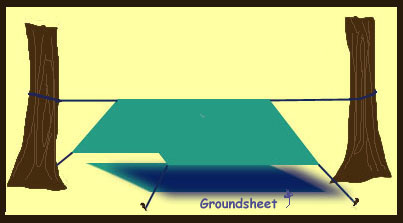  
Fire will sustain you indefinitely in the wild by warming you, cooking your food, and destroying the harmful germs commonly found in food and water.
|
|
| FIRE MAKING
- You should be able to build a fire with matches, under any weather conditions. Always carry matches in a waterproof case, when you have to shift around in a remote area.
Just remember and practice these few basic principles of fire building :
- Always select dry sheltered spots.
- Use only the driest of tinder to start a fire.
- Have a good supply of kindling on hand before striking the match.
- Start with a tiny fire and add fuel as the flame grows.
- Fire needs air. Add fuel sparingly.
- Blow lightly on the burning wood.
- Fire climbs. Place fresh kindling above the flame.
- Always use dry deadwood.
|
|
| FIRE SITE
- Use your judgement. Do not select a windy spot. Dry grounds are preferred and pick a spot where the fire will not spread, the last thing you wanna do is start a forest fire!!
In rainy weather, build under a leaning tree or a rock shelf.
|
|
| TINDER
- Tinder consists of dry grass or plant stems, dry inflammable bark such as birch or dry leaves, or any kind of material that takes the minimum heat catch alight.
|
|
| KINDLING
- Kindling is the wood used to raise the flames from the tinder so that larger and less combustible materials can be burnt. The best kindling consists of small, dry twigs and softer
woods are preferred because they flare up quickly.
|
|
| FUEL
- Not all wood burn alike. Some burn quickly and make a hit flame, some scarely burn at all. Some burn slowly and make good coals;some smoke. Use whatever it is at hand, but when there
is a choice, select the best fuels for the intended purpose. In general, hard woods make a slow burning fire with lasting coals, and soft woods make a quick, hot
fire with coals that are soon spent.
|
|
 It is well worth remembering the FIRE TRIANGLE. Its three sides represents AIR, HEAT, FUEL. If any one of the sides is removed, the triangle
collapse and the fire goes out.
It is well worth remembering the FIRE TRIANGLE. Its three sides represents AIR, HEAT, FUEL. If any one of the sides is removed, the triangle
collapse and the fire goes out.
When lighting a fire, always ensure adequate ventilation with enough fuel and a hot enough source to ignite this fuel. To produce a flame, this temperature must be
maintained to keep the air and fuel continously reacting. With more oxygen introduced, the fire will burn brighter, because by using the wind or forcing a draught, the fire is fanned to a high temperature
and rapidly burns fuel. By reducing the ventilation the fire burns less fiercely and embers are allowed to glow, needing less fuel.
If these principles are understood, smoky fires, which results from incomplete combustion, can be avoided.
|





 It is well worth remembering the FIRE TRIANGLE. Its three sides represents AIR, HEAT, FUEL. If any one of the sides is removed, the triangle
collapse and the fire goes out.
It is well worth remembering the FIRE TRIANGLE. Its three sides represents AIR, HEAT, FUEL. If any one of the sides is removed, the triangle
collapse and the fire goes out.

